The Google Campaign Manager 360 Offline Conversions API Program for Offline Conversions
The Google Campaign Manager 360 Offline Conversions API Program for Offline Conversions enables Google Display & Video 360 customers, Search Ads 360, and Campaign Manager 360 customers to understand the ROI of their advertising campaigns across online and offline purchase channels in one place. This enables closed-loop measurement of transactions tied to digital ad exposure to provide marketers a full understanding of the customer journey.
This attribution analysis is done by Google and attributed conversions are available in Google Display & Video 360, Search Ads 360, and Campaign Manager 360 reporting.
Note
LiveRamp's integration only covers offline conversions. Tag-based online conversion attribution must be implemented directly with Google.
This program utilizes the universal file, which can be used for multiple programs. For more information, see "Using a Universal File for Multiple Conversions API Programs".
The Google Campaign Manager 360 Offline Conversions API Program for Offline Conversions was formerly known as "the Google Campaign Manager Offline Conversions API Attribution Program".
Program Benefits
Utilizing info from the Campaign Manager 360 Offline Conversions API, advertisers can:
Further refine their ad campaign to optimize bids (manual or auto) to drive performance across omni channel
Exclude or remarket to existing customers
Provide personalized creative experiences
Overview of Steps Involved
The following steps need to be performed to enable the attribution analysis in Google Campaign Manager 360:
You authorize LiveRamp to send data to your Campaign Manager 360 account.
You grant LiveRamp user access to insert (upload) offline conversions to your account.
(Optional) If necessary, set up your Floodlight activities and custom Floodlight variables.
You send the generated IDs to LiveRamp.
You contact LiveRamp to set up additional audiences in Connect for each additional Floodlight activity, if necessary.
You send LiveRamp a sample conversion data file that follows the guidelines listed below.
You activate the campaign.
You send conversion data from the last 28 days to LiveRamp.
LiveRamp matches the data and delivers your data to your Google Campaign Manager 360 account.
You view the attribution analysis in Google Campaign Manager 360, DV360, and Search Ads 360.
See the appropriate sections below for more information on performing these steps.
Authorize LiveRamp to Send Data
Contact your DV360 Account Manager to inform them you wish to enable the LiveRamp + DV360 integration. Once you receive an email from your DV360 Account Manager asking for confirmation to allow LiveRamp to send data into your account, provide confirmation.
Grant LiveRamp User Access in Campaign Manager 360
This step will grant LiveRamp access to insert offline conversion data into your Campaign Manager 360 account. The permission given will only allow LiveRamp to insert offline conversions via the API.
Tip
Save the ID: Once you’ve created a new user profile for LiveRamp, record the LiveRamp Access Profile ID so you can send it to us in a later step.
To grant access in Campaign Manager 360:
Create a new user role:
From the navigation menu in Campaign Manager 360, select and then select .
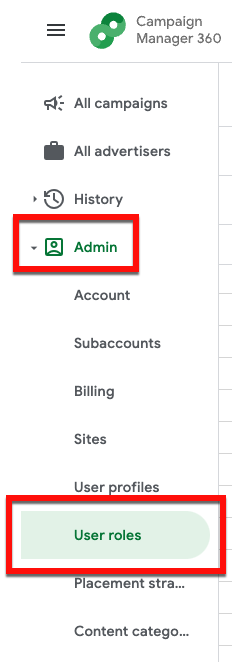
From the User Roles page, click .
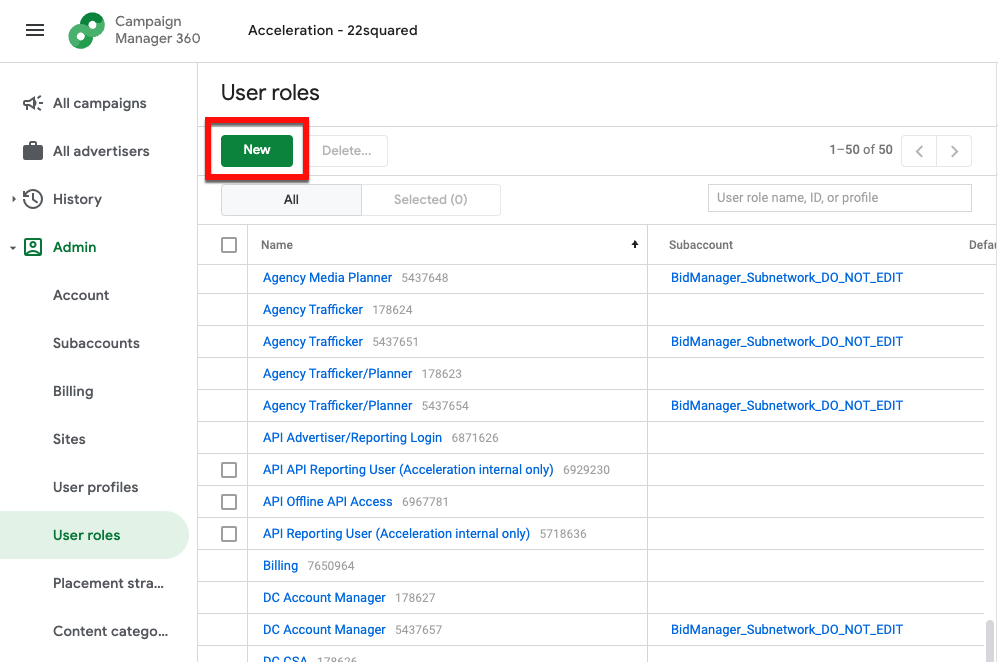
In the “User role name” field, enter “Offline API Access”.
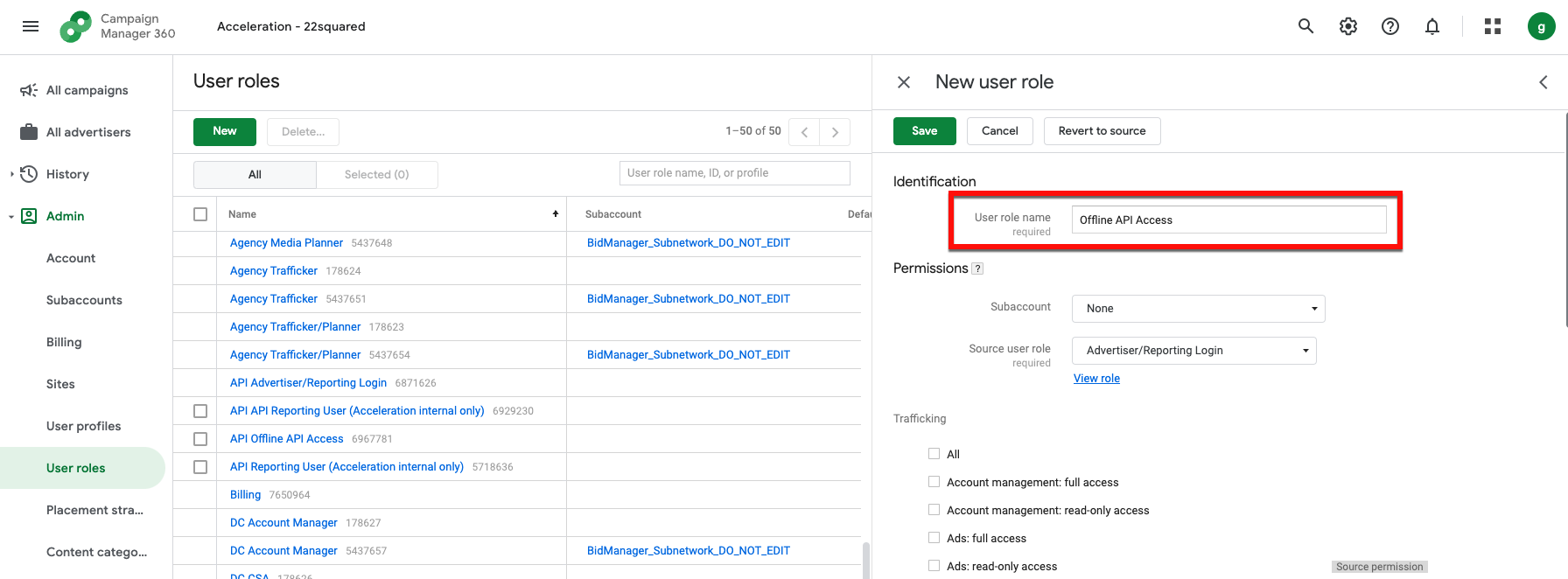
In the “Source user role” field, select “Advertiser/Reporting Login”.
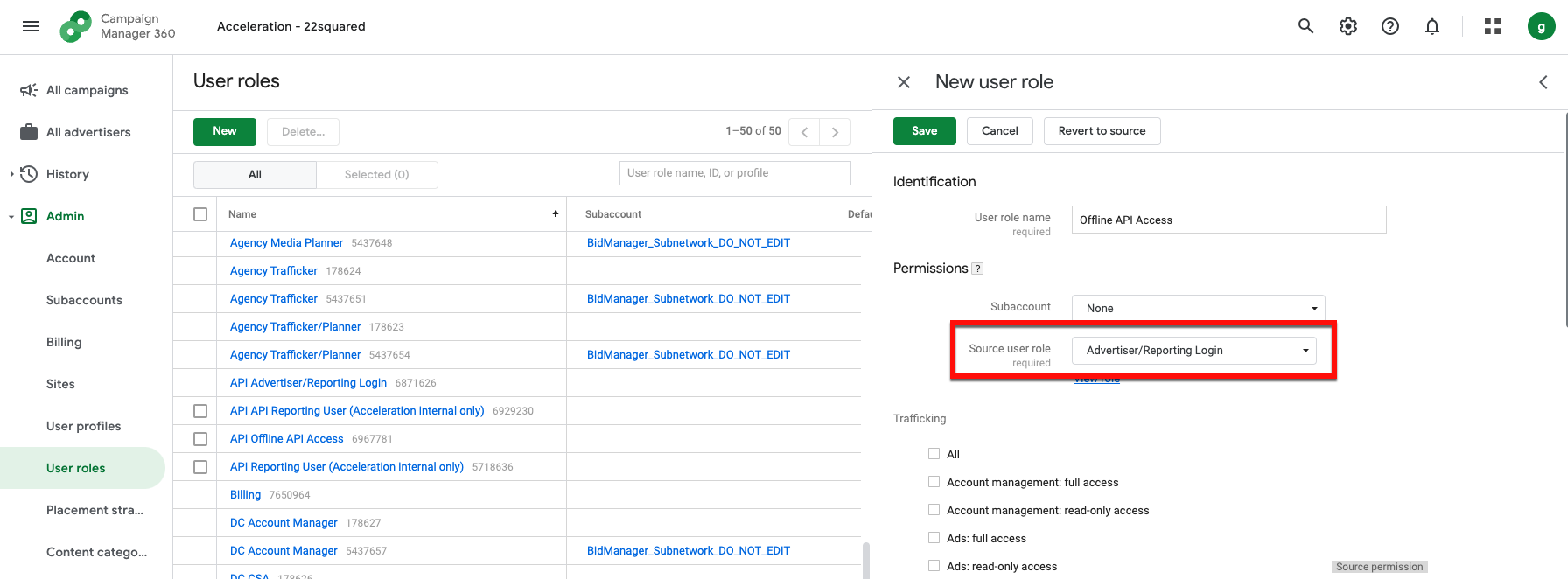
In the Reporting section, uncheck all check boxes and check the check boxes for “Insert offline conversions” and "Update offline conversions".
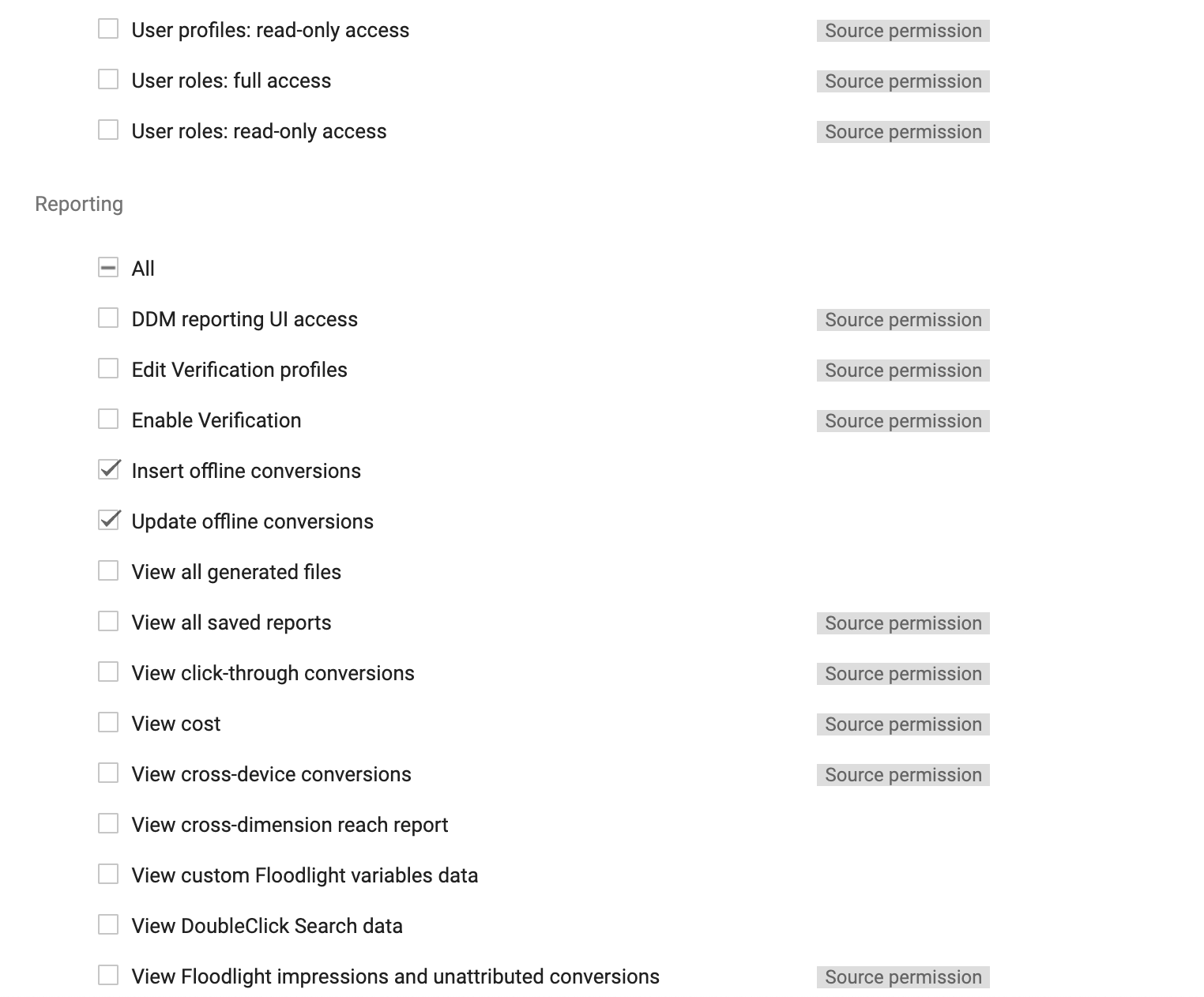
Click .
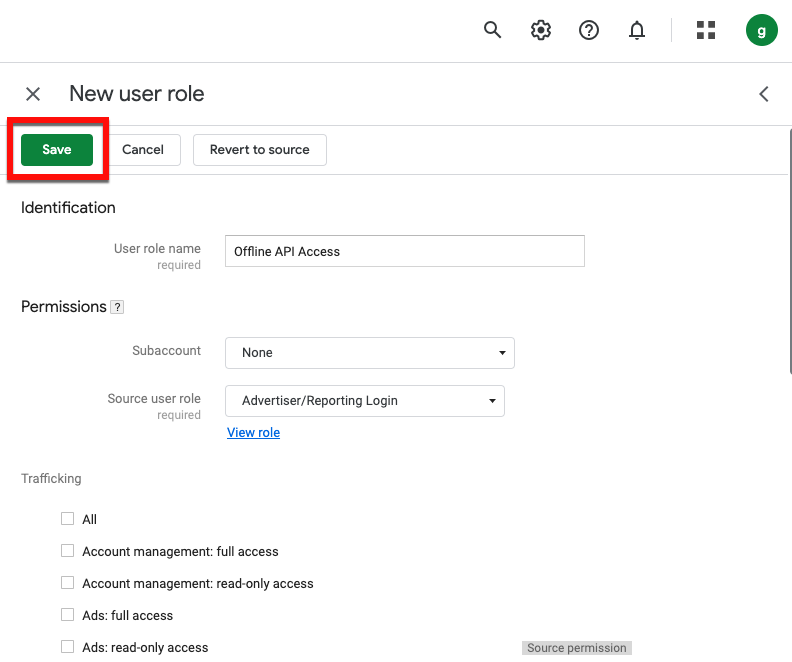
Create a new user profile:
From the navigation menu, select and then select .
From the User Profiles page, click .
Enter the following information:
Email: googleauth@liveramp.com
Profile name: LiveRampAPIAccess
Note
Google might add a number at the end of this name– this is okay.
User role: Offline API Access
Click .
Set Up Floodlight Activities and Custom Floodlight Variables
Note
Because this program uses the universal file that allows you to add in granular product details, you do not need to set up Floodlight variables to pass item-level data.
You can still use the Floodlight variables to pass information related to the transaction, and not per item.
Floodlight Activities
Floodlight activities are used as conversion tags in DV360 to group conversions. For example, if you manage multiple brands, you might use a different Floodlight activity for each brand. This enables Campaign Manager 360 reporting to filter by advertising campaign conversions.
Note
You can use up to five Floodlight activities with your LiveRamp integration. Each Floodlight activity requires a corresponding LiveRamp audience. Follow the steps in the "Create Additional Audiences" section to create additional audiences if you use more than one Floodlight activity.
If you haven't set up Floodlight activities for a prior campaign, follow the steps below to create Floodlight activities.
To create a Floodlight activity in Campaign Manager 360:
From the navigation menu, select and click on the desired advertiser name.
Create a new Floodlight activity group:
From the navigation menu, select and then select .
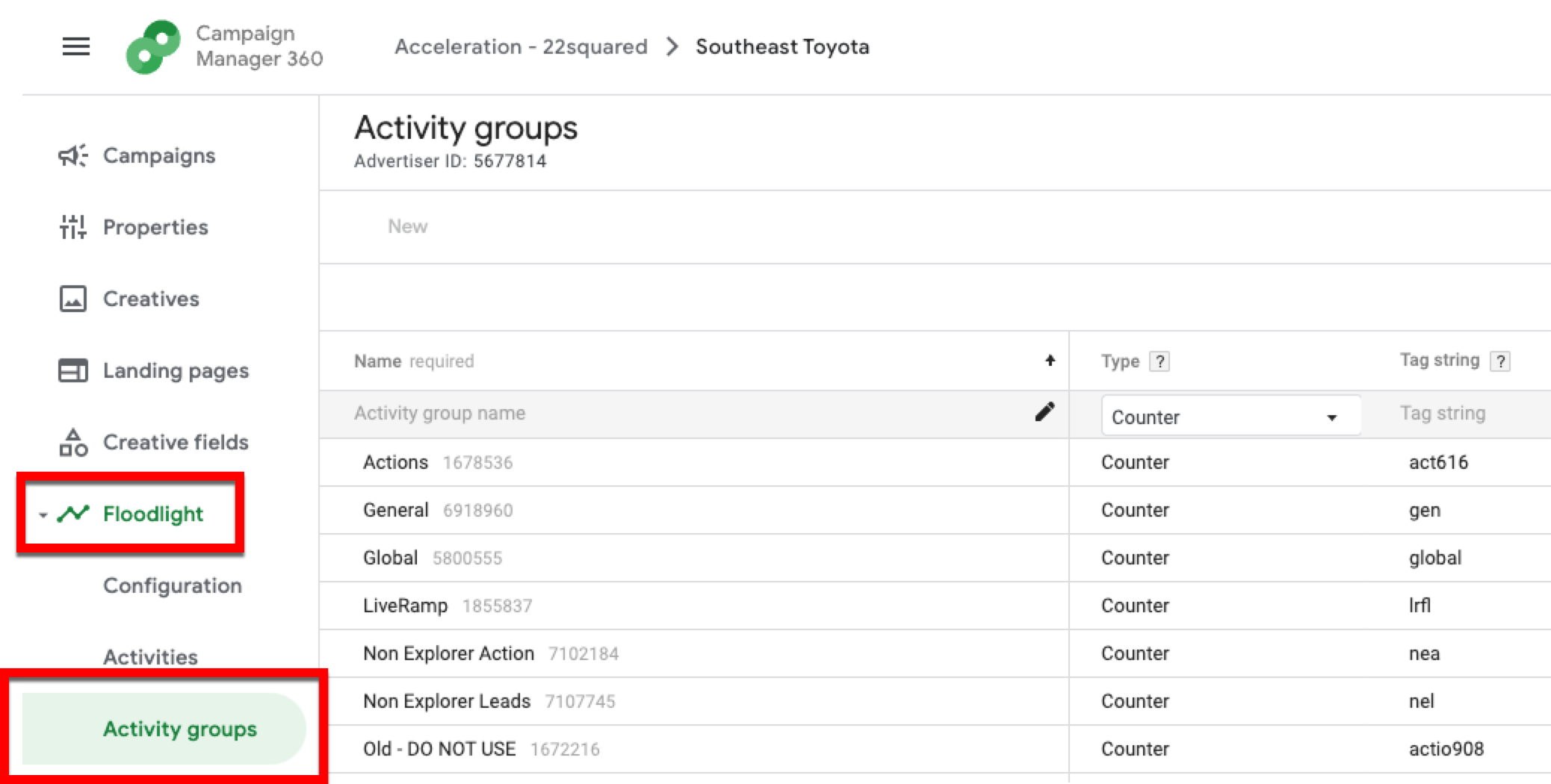
Click .
Fill out the required fields.
Click .
Create a new Floodlight activity:
From the navigation menu, select and then select .
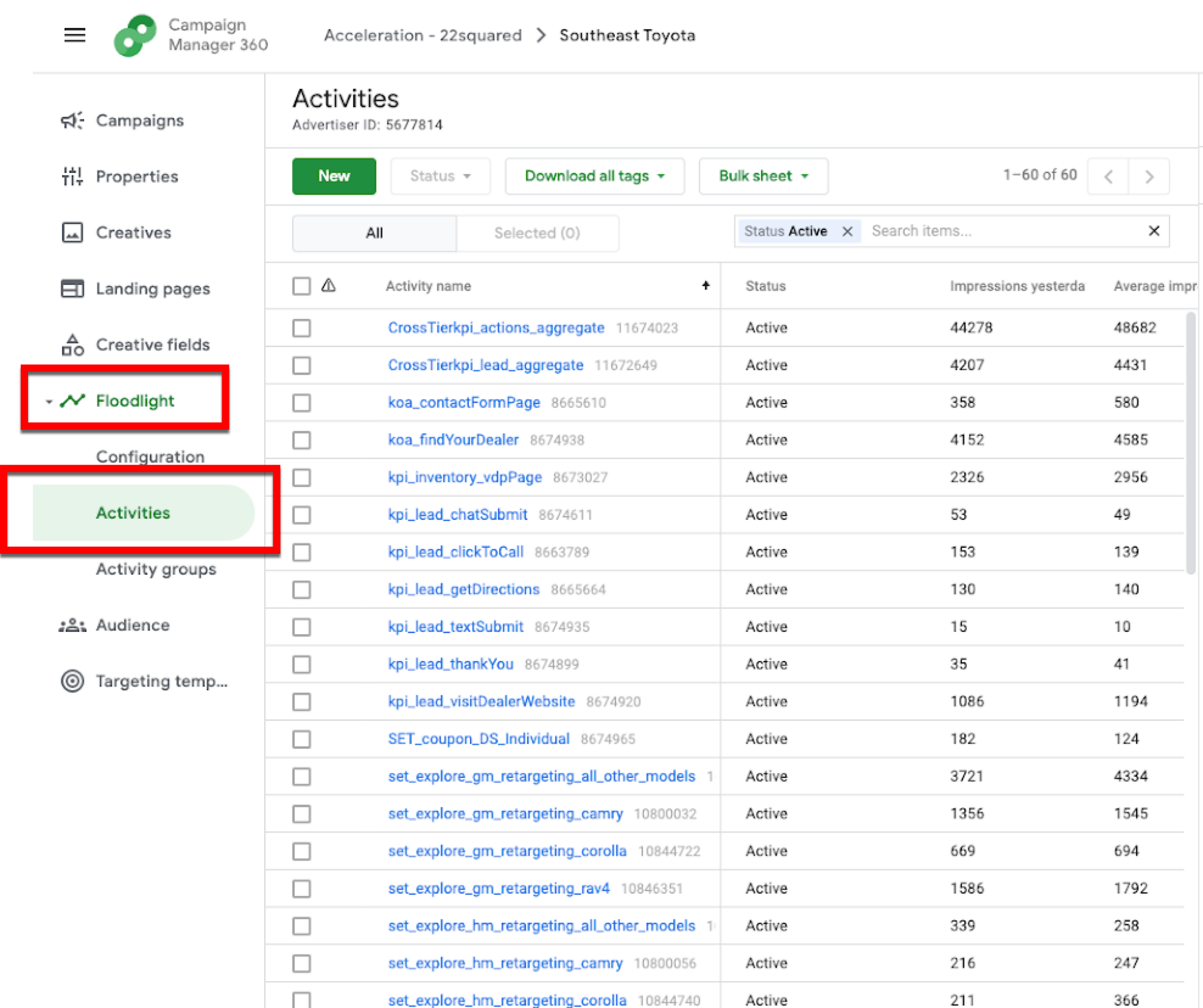
Click .
Fill out the required fields and then click .
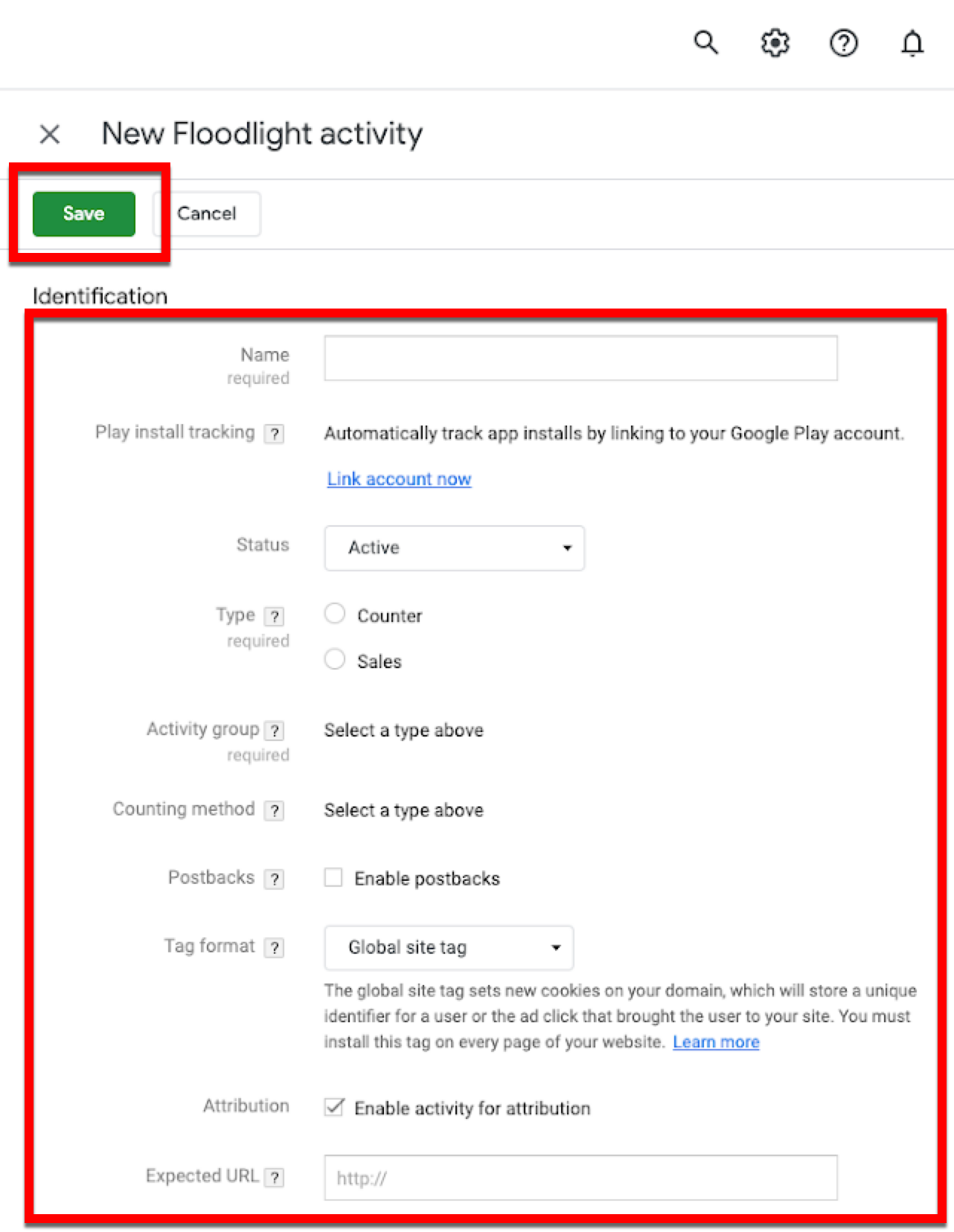
Follow the same process (apart from selecting the advertiser name) to create additional Floodlight activities.
Note
Typically, a maximum of five Floodlight activities can be used with the LiveRamp integration. Contact LiveRamp to create additional audiences if you use more than one Floodlight activity. Talk to your LiveRamp representative if more than five Floodlight activities are needed for your situation.
Custom Floodlight Variables
Custom Floodlight variables allow you to further categorize your conversions for each Floodlight activity by such categories as product groups, customer type, or conversion channels (e.g., in-store sales or phone sales). Each variable is given an ID starting with “U” (such as “U1”). You create a variable name (the “friendly name”) and select the appropriate data type (string or number) when creating the variable.
If you are setting floodlight variables for cases where you are sending item-level data, you should use floodlight variables to represent the transaction and apply the same value for each item as part of the single order/transaction.
Use custom Floodlight variables in the way that makes the most sense for your situation. For example, if your offline conversions goal is to track the different customer types that make an in-store purchase, you might create the following custom Floodlight variables and include the following variables fields in your conversion files:
Custom Floodlight Variable ID | Friendly Name | Field Name |
1 | New Customer | U1 |
2 | Reactivated Customer | U2 |
3 | Existing Customer | U3 |
If your offline conversions goal is to track the different channels through which a customer converts, you might create the following custom Floodlight variables and include the following variables fields in your conversion files:
Custom Floodlight Variable ID | Friendly Name | Field Name |
1 | In-Store | U1 |
2 | Phone | U2 |
3 | Catalog | U3 |
Your team with access to the Campaign Manager UI will need to create these variables. For more information and instructions on creating variables, see Google’s documentation.
Caution
Variable limitations: While Google allows you to create up to 100 variables per Floodlight configuration with no maximum variable name length, LiveRamp can only accept a maximum of 45 variables and variable names of 50 characters or less.
These variables (also referred to as "U variables") are placed at the end of the conversion data file, with each column named with the variable number (such as "u1", "u2", "u3", etc., up to a maximum of 45 variables.
Keep the following in mind:
Each U variable should only have one value per record.
U variable values cannot contain commas. For example: "San Francisco, CA" is not permitted.
U variables need to be consistent across all files within the same Floodlight configuration.
Locate Your Floodlight Custom Variable IDs
Your conversion data files will need to include the appropriate Floodlight custom variable IDs (such as “u1”) in the column headings.
To find the variable IDs in Campaign Manager 360:
From the navigation menu, select and click on the desired advertiser name.
From the navigation menu, select and then select .

Scroll down to the Custom Floodlight variables section.
Find the numeric values for the variables you want to include.
In the above example, the Floodlight variable for “Language” would be "u1."
Send IDs to LiveRamp
Once you’ve completed the steps above, send an email to your LiveRamp representative that includes the following information:
Confirmation that you have completed all steps above.
The LiveRamp Access Profile ID.
All cart items under your order.
Up to five Floodlight Activity IDs.
Format the File
Before sending your conversion data to LiveRamp, make sure to strictly follow the guidelines listed below:
Note
If any guidelines listed here conflict with the guidelines in our general file formatting instructions, follow these guidelines.
Once the file has been formatted correctly, upload the file to LiveRamp. See the “Upload the File” section below for more information.
Note
Once you set up the file format for an existing conversions program feed, try to keep the file format (such as the column headers or the column order) the same for all subsequent files. If you change the file format for an existing feed, create a support case before uploading the new file to ensure your existing feeds are not impacted. For more information, see "Changing the Format of an Existing File".
Using the Universal File Template
To make things easier for you, we've created a universal file template that you can use.
Note
The template contains formatting instructions in the second row of the file, along with info on whether a column is required and whether values are required, depending on which conversions programs you're using. You can also refer to the information in the "List of All Universal File Columns" section below.
Download the file template by clicking here.
If desired, you can remove any non-required columns that aren't utilized by one of your conversions programs, but you can also leave those columns in the file and not populate them with values.
Transfer your data into the template.
After transferring your data into the file template, delete the second row with the formatting instructions.
Save the file in one of our allowed file types (.csv, .tsv, .psv, or .txt).
Upload the file to LiveRamp.
List of All Universal File Columns
The table below lists all possible columns you might include in your universal file, along with the following information:
The columns that are always required
The columns that are required in certain situations, such as the types of identifiers you're sending or the conversions programs you're using
Whether values are required for each column
Formatting instructions for column values
Which columns are utilized by which conversions programs, when applicable
Column Name | Column Required? | Values Required? | Notes | Programs That Utilize This Field |
|---|---|---|---|---|
first_name | Yes | Yes (if Name and Postal is used as an identifier) |
| |
last_name | Yes | Yes (if Name and Postal is used as an identifier) |
| |
address_1 | Yes | Yes (if Name and Postal is used as an identifier) |
| |
address_2 | Yes | No |
| |
city | Yes | Yes (if Name and Postal is used as an identifier) |
| |
state | Yes | Yes (if Name and Postal is used as an identifier) |
| |
zip | Yes | Yes (if Name and Postal is used as an identifier) |
| |
email_1 | Yes | Yes (if email is used as an identifier) |
| |
email_2 | Yes | No |
| |
email_3 | Yes | No |
| |
email_4 | Yes | No |
| |
transaction_category | Yes | Yes |
| |
transaction_timestamp | Yes | Yes |
| |
transaction_amount | Yes | Yes |
| |
phone_1 | Yes | Yes (if phone is used as an identifier) |
| |
phone_2 | Yes | No |
| |
order_id | Yes | Yes |
| |
item_number | No | Yes (if this column is included in the file) |
|
|
quantity | Yes | Yes (if this column is included in the file) |
|
|
product_id | No | Yes (if this column is included in the file) |
|
|
store_id | No | Yes (if this column is included in the file) |
|
|
Country | Yes (for TTD only) | Yes (if this column is included in the file) |
|
|
Region | Yes (for TTD only) | Yes (if this column is included in the file) |
|
|
Metro | No | No |
|
|
City | No | No |
|
|
product_name | No | No |
|
|
promo_code | No | No |
|
|
product_category | No | No |
|
|
product_subcategory | No | No |
|
|
product_variant | No | No |
|
|
product_brand | No | No |
|
|
event_conversion_type | Yes (for Snapchat only and only if sending online data) | Yes (if this column is included in the file) | Use one of the following source types:
|
|
is_new_customer | No | No |
|
|
product_price | No | No |
|
|
GTIN | No | No |
|
|
department | No | No |
|
|
brand | No | No |
|
|
custom_field | No | No |
|
|
data_processing_options | Yes (for Meta Conversions API or FBOC only) | Yes |
|
|
data_processing_options_state | Yes (for Meta Conversions API or FBOC only) | No |
|
|
data_processing_options_country | Yes (for Meta Conversions API or FBOC only) | No |
|
|
ad_user_data | Yes (for UK and EMEA data) | No |
|
|
ad_personalization | Yes (for UK and EMEA data) | No |
|
|
Send Conversion Data to LiveRamp
In order for LiveRamp to match offline conversion data against anonymous CM360/SA360/DV360 users targeted during your advertising campaigns, provide LiveRamp with sample conversion data that includes offline identifiers (usually PII).
Once your campaign has started, send conversion data to LiveRamp at your preferred cadence (daily, weekly, monthly, etc.). Google strongly recommends that you upload conversion files on a daily basis to provide the most up-to-date reporting and minimize any risks of data gaps. Do not send more than one file per day.
Tip
Most customers automate this process to send files on a regular cadence.
Caution
If there are transactions pertaining to different Floodlight activity IDs, separate the transactions into separate files based on Floodlight activity. Each file should be uploaded into the appropriate LiveRamp audience for that particular Floodlight activity on Connect.
Caution
Most platforms require that at least 1,000 unique transaction events be uploaded over a 28-day period.
Conversion Data Guidelines
Each conversion data record must include at least one PII identifier (name and postal address, email, or phone) and the required conversion data:
Transaction category
Transaction timestamp
Transaction amount
Quantity
Order ID (ordinal)
Merchant ID
Caution
The values in the “transaction category” column are for LiveRamp’s internal processing only and do not get passed on to Google. Do not use the “transaction category” column to categorize your transactions. Either separate your transactions into different Floodlight activities or assign Floodlight custom variables (u-variables) to your transactions.
Other optional conversion data (such as custom Floodlight variables) can be included as well. See the “Format the File” section for more information.
Make sure to also follow these additional guidelines:
Avoid sending duplicate transactions (transactions already sent to LiveRamp). If you send weekly or monthly files, only send transactions that occurred since the previous file was sent.
Do not include transactions that occurred more than 28 days ago. LiveRamp can only match transactions to clicks that occurred in the last 28 days.
Do not include conversions with a conversion date in the future.
Upload the File
Upload conversion data files using LiveRamp’s SFTP server or your SFTP server.
You can also have us pull files from an AWS S3 bucket or GCS bucket. See “Getting Your Data Into LiveRamp” for more information.
Caution
Files for Google Campaign Manager 360 cannot be uploaded via Connect. We recommend either uploading via our SFTP server or having us pull files from an S3 bucket.
To upload files using LiveRamp's SFTP: Use the credentials provided by your technical contact once the agreement has been signed and follow the instructions in “Upload a File via LiveRamp's SFTP”.
To upload files using your SFTP: Follow the instructions in “Upload a File via Your SFTP”.
Once the file is uploaded, information on file processing status can be viewed in Connect on the Files page.
Note
Upload transactions on a daily basis to provide the most up to date reporting and minimize any risks of data gaps.
Most customers automate this process to send files on a regular cadence. Use the same SFTP subdirectory or S3 bucket that you used to upload your sample conversion data. Google strongly recommends that you upload conversion files on a daily basis to provide the most up to date reporting and minimize any risks of data gaps.
FAQs
You may take the file you are working with for the Google Store Sales Improvements (GSSI) program and perform the following actions in order to use it with Google Campaign Manager 360 Offline program (see “The Google Store Sales Improvements Conversions API Program for Offline Conversions” for more information):
Note
You might want to use a universal file for most or all of your conversions programs. For more information, see "Using a Universal File for Multiple Conversions API Programs".
Add the following fields:
quantity
order_id (ordinal)
Cart items under the ordinal, including product lists
If needed, floodlight custom variable IDs (“U1”, “U2”, etc., if the order cart items are not being used)
Make sure that the modified file has the fields shown below in the order listed:
first_name
last_name
address_1
address_ 2
city
state
zip
email_1
email_2
email_3
email_4
transaction _category
transaction_timestamp
transaction_amount
phone_1
phone_2
quantity
order_id (ordinal)
All the order cart items listed under the ordinal
Floodlight custom variable IDs (“U1”, “U2”, etc., if the order cart items are not being used)
Google recommends that you use the Campaign Manager 360 Offline Conversions API.
Conversions uploaded with the Campaign Manager Offline Conversions API are available in Campaign Manager 360, Search Ads 360, and Display & Video 360.
Google recommends that you upload transactions on a daily basis to provide the most up-to-date reporting and minimize any risks of data gaps.
Include all traceable offline conversions in your delivery. Do not include online conversion data.
Avoid sending duplicate transactions (transactions already sent to LiveRamp). If you send weekly or monthly files, only send transactions that occurred since the previous file was sent.
Do not include transactions that occurred more than 28 days ago. LiveRamp can only match transactions to clicks that occurred in the last 28 days.
Do not include conversions with a conversion date in the future.
Each product should be its own record, with a "conversion quantity" of “1” and its granular item value in the “transaction_amount” field.
Use the “order_id” field to insert a unique ID that represents the transaction. This would be the same across all conversions in a transaction.
See the example below:
order_id | transaction_amount | product_id | quantity | product_price |
|---|---|---|---|---|
1234 | 19.99 | 835823 | 1 | 19.99 |
1234 | 22.50 | 38483 | 3 | 7.50 |
The total setup for the Campaign Manager 360 Offline Conversions API will take about a week. After the delivery is sent, it will take approximately 2-3 days before you may view the conversion data in CM360.
For any further questions, create a case in the LiveRamp Community portal.
Total Conversions is a metric you see within Google’s platform. Google defines Total Conversions as all conversions within a specific reporting period. It is the aggregate of the deduplicated transactions that were recognized as a conversion.
In order for any given conversion to count towards Total Conversions, the “quantity” field must contain a value of at least “1”. A deduplicated transaction with a quantity of “1” will count as 1 conversion in the Total Conversions metric. A transaction with a quantity greater than “1” will increase the Total Conversions bottom line.
Note
If your Total Conversions is higher than expected and the values in your “quantity” field are greater than 1, we recommend defaulting all “quantity” values to “1”.